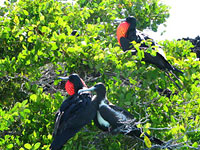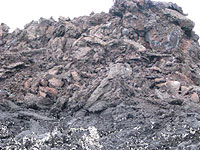

 | |||||||||||||||
|
|
Journals 2008/2009Tom Bogard
September 7, 2008 I awoke to another beautiful day! It was sunny with a few clouds. The seas were calm and we had a smooth night at anchor. I will have to use lots of the SPF 50 sun block that I brought. This close to the equator with the almost perpendicular angle of the sun's rays it is very easy to get a sunburn. It has been hard to keep track of what day of the week it is (I was not the only one). With help I was able to determine that it was Sunday. We got suited up again right after breakfast and boarded the panga for another day of surveying. Today's plan is to work from the panga, spend some time on land checking PIT tags, and to survey from the big boat while sailing to another area. In addition to penguins and cormorants, the organisms that are being counted include Sea Lions, Green Sea Turtles, feral cats, Marine Iguanas, Blue Footed Boobies, Masked Boobies, Nazca Boobies, Brown Pelicans, and Great Blue Herrons. Today we went into a shallow mangrove area/cove. The bright green of the mangrove leaves were in contrast to the very dark shades of the lava flows. While in the cove we several more Green Sea Turtles, Eagle Rays (smaller than a Manta), and incredible male Frigate Birds. Cove was home to a breeding colony of Frigate Birds with approximately 200 males. To attract females the males inflate a bright red gullet pouch. The brighter and showier the display, the better the males chances of attracting a mate. It is quite an impressive display to be in the midst of so many birds. While in the cove we saw a large Zodiac of tourists from a cruise boat. Other than a boat off in the distance, this is the first time since we left Puerto Villamil that we had seen other people.I have become very fascinated with the volcanoes of the islands and the landscapes they produce. It is difficult, if not impossible, to adequately describe what I saw. The volcanoes are immense and the tops are usually shrouded in clouds giving them a remote, surreal feeling. The landscape is alien and almost other worldly. There are vast expanses of very dark, almost black, lava fields and plains. The lava planes are not planes in the common understanding of this type of land feature. Seen from a distance they appear to be flat, rough textured, and somewhat featureless. As you get closer you see more detail and variations in the landscape. There are ridges and valleys that could be as much as 7 meters from top to bottom and areas where the surface is almost smooth (due to variations in the viscosity of the lava). There are slight variations in the lava flows that are frozen on the flanks of the volcanoes - perhaps due to slight differences in chemical composition, their relative ages, and the effects of weathering. The flows form patterns on the slopes of the volcanoes that sometimes seem to intertwine. They are for the most part are so recent (in the 100's if years?) that they have not had time for vegetation to become widely established or form any type of soil. Many areas are completely void of any type of vegetation. The relative age of the different flows is evident in the amount of vegetation that was present. The older the flow the greater the amount of vegetation it had. I am sure that there have been times where vegetation, including trees, was established only to be wiped out by the flowing lava. Walking on the lava flows is very dangerous and difficult. The rocks are very sharp (I have the cuts, scrapes, and torn clothes to prove it!) and vesicled. The surface can be loose and breaks easily; you cannot tell if the surface will hold and if it does not, you don't know if you will fall a couple of centimeters or larger distance. When the rock does break it creates a glassy almost musical sound. The flows could slope gently down to the ocean or could form cliffs as high as 20 meters with the occasional lava tube. In viewing these volcanic scenes I felt an overwhelming sense of desolate beauty. It is almost impossible to imagine the magnitude of the forces that created the islands. Getting off the panga and onto the shore could be an exciting experience. If there was a clear beach without any visible underwater obstructions the panga would go right up to the water line and we could jump off - no problem. The majority of the time there was no beach, only a rocky shore. The procedure was for the panga driver to find just the right spot, put and hold the bow of the boat against a rock, and the people walk over the bow and scramble onto the rocky, often slippery shore. During this procedure the panga was pitching and rolling with the waves. Timing was the key to a successful landing! Once the people who were getting off were on shore, the panga driver quickly backed off the rock and waited in deeper water. To get back on the boat the process was reversed. Although there were a couple of close calls, luckily during the entire trip no one fell into the water or on the rocks. Again, it was just all part of the adventure. Tomorrow is going to be an early day. We have to get up at 4:30 to leave in the panga by 5:15.
|
||||||||||||||


